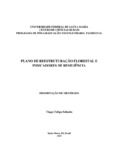| dc.creator | Schulte, Tiago Felipe | |
| dc.date.accessioned | 2016-05-04 | |
| dc.date.available | 2016-05-04 | |
| dc.date.issued | 2015-02-27 | |
| dc.identifier.citation | SCHULTE, Tiago Felipe. Restructuring plan forest and indicators of resilience. 2015. 93 f. Dissertação (Mestrado em Recursos Florestais e Engenharia Florestal) - Universidade Federal de Santa Maria, Santa Maria, 2015. | por |
| dc.identifier.uri | http://repositorio.ufsm.br/handle/1/8770 | |
| dc.description.abstract | The present paper studied the floristic composition, structure and volume of a forest with an area of 120.2 hectares, called Forest Secret Massif, located in the village of Figueira, Segredo s city, Rio Grande do Sul, in order to create the VCA indicator (expanded margin call), RNR indicator (natural regeneration relative) and IRF indicator (forest resilience rating) to describe the representativeness of species in the forest. Also evaluated the phenotypic aspects of the trees and the related of competition at the trees in order to propose a forest restructuring plan by removing mature trees and regenerating trees in order to improve the conditions of the forest and noble species. The three indicators, on a percentage scale, presented able to describe the representation of mature species (VCA), the regenerating species (RNR) and both the forest formation (IRF), which allowed understand the current situation of each species and will understand the changes that may be manifested in the implementation of management plans, obtaining a history. The restructuring plan has listed 13,139 mother trees, 31,820 normal trees and 10,210 trees subject to deletion (group 1), 2.095 noble trees (group 2), 2776 bagueiras (group 3), 4,538 important trees for the forest ecology maintenance (group 4) ; and 24,454 individuals subject to removal for strategic reasons, except the 7,365 needed to stand on environmental issues (group 5). The regenerating forest comes up with 18,430 trees future level 1, 56 415 trees future level 2 and 17,107 trees future level 3. | eng |
| dc.format | application/pdf | por |
| dc.language | por | por |
| dc.publisher | Universidade Federal de Santa Maria | por |
| dc.rights | Acesso Aberto | por |
| dc.subject | Manejo florestal | por |
| dc.subject | Valor de cobertura | por |
| dc.subject | Regeneração natural | por |
| dc.subject | Serviços ambientais | por |
| dc.subject | Supressão | por |
| dc.subject | Forest management | eng |
| dc.subject | Margin calls | eng |
| dc.subject | Nature regeneration | eng |
| dc.subject | Environmental services | eng |
| dc.subject | Suppression | eng |
| dc.title | Plano de reestruturação florestal e indicadores de resiliência | por |
| dc.title.alternative | Restructuring plan forest and indicators of resilience | eng |
| dc.type | Dissertação | por |
| dc.description.resumo | O presente trabalho estudou a composição florística, estrutural e volumétrica de uma floresta com área de 120,2 hectares, denominada de Maciço Florestal Segredo, situado na localidade de Figueira, no município de Segredo, Rio Grande do Sul, com o objetivo de criar o indicador (valor de cobertura ampliado), (regeneração natural relativa) e (índice de resiliência florestal) para descrever a representatividade das espécies na floresta. Também se avaliou os aspectos fenotípicos e relacionados à competição das árvores com o objetivo de propor um plano de reestruturação florestal por meio da supressão de árvores maduras e de regenerantes, a fim de melhorar as condições da floresta e de espécies nobres. Os três indicadores, em uma escala percentual, se apresentaram capazes de descrever a representatividade das espécies maduras ( ), das espécies regenerantes ( ) e de ambas na formação da floresta ( ), o que permitiu entender a atual situação de cada espécie e permitirá entender as alterações que poderão se manifestar com a aplicação de planos de manejo, obtendo-se um histórico. O plano de reestruturação elencou 13.139 árvores matrizes, 31.820 árvores normais e 10.210 árvores passíveis de supressão (grupo 1), 2.095 árvores nobres (grupo 2), 2.776 bagueiras (grupo 3), 4.538 árvores importantes para manutenção da ecologia florestal (grupo 4); e 24.454 indivíduos passíveis a supressão por motivos estratégicos, salvo os 7.365 necessários a se manter por questões ambientais (grupo 5). A floresta regenerante surge com 18.430 árvores futuro nível 1, 56.415 árvores futuro nível 2 e em 17.107 árvores futuro nível 3. | por |
| dc.contributor.advisor1 | Farias, Jorge Antonio de | |
| dc.contributor.advisor1Lattes | http://lattes.cnpq.br/9537008908546721 | por |
| dc.contributor.referee1 | Balbinot, Rafaelo | |
| dc.contributor.referee1Lattes | http://lattes.cnpq.br/7862635734299980 | por |
| dc.contributor.referee2 | Vaccaro, Sandro | |
| dc.contributor.referee2Lattes | http://lattes.cnpq.br/9165426389524637 | por |
| dc.creator.Lattes | http://lattes.cnpq.br/3203627533883441 | por |
| dc.publisher.country | BR | por |
| dc.publisher.department | Recursos Florestais e Engenharia Florestal | por |
| dc.publisher.initials | UFSM | por |
| dc.publisher.program | Programa de Pós-Graduação em Engenharia Florestal | por |
| dc.subject.cnpq | CNPQ::CIENCIAS AGRARIAS::RECURSOS FLORESTAIS E ENGENHARIA FLORESTAL | por |


